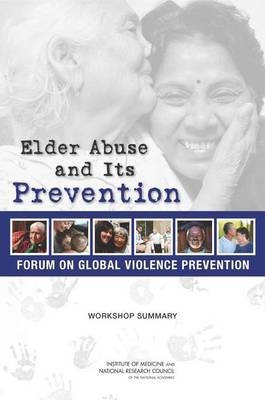
Elder Abuse and Its Prevention
National Academies Press (Verlag)
978-0-309-29351-8 (ISBN)
Elder Abuse and Its Prevention is the summary of a workshop convened in April 2013 by the Institute of Medicine's Forum on Global Violence Prevention. Using an ecological framework, this workshop explored the burden of elder abuse around the world, focusing on its impacts on individuals, families, communities, and societies. Additionally, the workshop addressed occurrences and co-occurrences of different types of abuse, including physical, sexual, emotional, and financial, as well as neglect. The ultimate objective was to illuminate promising global and multisectoral evidence-based approaches to the prevention of elder maltreatment. While the workshop covered scope and prevalence and unique characteristics of abuse, the intention was to move beyond what is known about elder abuse to foster discussions about how to improve prevention, intervention, and mitigation of the victims' needs, particularly through collaborative efforts. The workshop discussions included innovative intervention models and opportunities for prevention across sectors and settings.
Violence and related forms of abuse against elders is a global public health and human rights problem with far-reaching consequences, resulting in increased death, disability, and exploitation with collateral effects on well-being. Data suggest that at least 10 percent of elders in the United States are victims of elder maltreatment every year. In low- and middle-income countries, where the burden of violence is the greatest, the figure is likely even higher. In addition, elders experiencing risk factors such as diminishing cognitive function, caregiver dependence, and social isolation are more vulnerable to maltreatment and underreporting. As the world population of adults aged 65 and older continues to grow, the implications of elder maltreatment for health care, social welfare, justice, and financial systems are great. However, despite the magnitude of global elder maltreatment, it has been an underappreciated public health problem. Elder Abuse and Its Prevention discusses the prevalence and characteristics of elder abuse around the world, risk factors for abuse and potential adverse health outcomes, and contextually specific factors, such as culture and the role of the community.
Table of Contents
Front Matter
1 Introduction
2 Measuring and Conceptualizing Elder Abuse
3 Risk Factors and Health Outcomes
4 Ethical Considerations
5 Screening and Prevention
6 The Way Forward
Part II: Papers and Commentary from Speakers
II.1 Understanding Elder Abuse in the Chinese Community: The Role of Cultural, Social, and Community Factors--E-Shien Chang and XinQi Dong
II.2 Seven Policy Priorities for an Enhanced Public Health Response to Elder Abuse--Marie-Therese Connolly and Ariel Trilling
II.3 Elder Neglect: The State of the Science--Terry T. Fulmer and XinQi Dong
II.4 Native Elder Mistreatment--Lori L. Jervis
II.5 Elder Financial Abuse--Ronald Long
II.6 Elder Abuse and Its Prevention: Screening and Detection--Tara McMullen, Kimberly Schwartz, Mark Yaffe, and Scott Beach
II.7 Elder Abuse and Neglect: A Role for Physicians--James G. O'Brien
II.8 Preventing Elder Abuse - Hope Springs Eternal--Elizabeth Podnieks and Cynthia Thomas
II.9 Elder Abuse Intervention: The Shelter Model and the Long-Term Care Facility--Daniel A. Reingold, Joy Solomon, and Malya Levin
II.10 Elder Abuse in Asia - An Overview--Elsie Yan
References
Appendixes
Appendix A: Workshop Agenda
Appendix B: Speaker Biographical Sketches
1 Front Matter; 2 1 Introduction; 3 2 Measuring and Conceptualizing Elder Abuse; 4 3 Risk Factors and Health Outcomes; 5 4 Ethical Considerations; 6 5 Screening and Prevention; 7 6 The Way Forward; 8 Part II: Papers and Commentary from Speakers; 9 II.1 Understanding Elder Abuse in the Chinese Community: The Role of Cultural, Social, and Community Factors--E-Shien Chang and XinQi Dong; 10 II.2 Seven Policy Priorities for an Enhanced Public Health Response to Elder Abuse--Marie-Therese Connolly and Ariel Trilling; 11 II.3 Elder Neglect: The State of the Science--Terry T. Fulmer and XinQi Dong; 12 II.4 Native Elder Mistreatment--Lori L. Jervis; 13 II.5 Elder Financial Abuse--Ronald Long; 14 II.6 Elder Abuse and Its Prevention: Screening and Detection--Tara McMullen, Kimberly Schwartz, Mark Yaffe, and Scott Beach; 15 II.7 Elder Abuse and Neglect: A Role for Physicians--James G. O'Brien; 16 II.8 Preventing Elder Abuse - Hope Springs Eternal--Elizabeth Podnieks and Cynthia Thomas; 17 II.9 Elder Abuse Intervention: The Shelter Model and the Long-Term Care Facility--Daniel A. Reingold, Joy Solomon, and Malya Levin; 18 II.10 Elder Abuse in Asia - An Overview--Elsie Yan; 19 References; 20 Appendixes; 21 Appendix A: Workshop Agenda; 22 Appendix B: Speaker Biographical Sketches
| Verlagsort | Washington |
|---|---|
| Sprache | englisch |
| Maße | 152 x 229 mm |
| Themenwelt | Medizin / Pharmazie ► Gesundheitswesen |
| Medizin / Pharmazie ► Medizinische Fachgebiete ► Geriatrie | |
| Sozialwissenschaften ► Pädagogik ► Sozialpädagogik | |
| Sozialwissenschaften ► Soziologie | |
| ISBN-10 | 0-309-29351-0 / 0309293510 |
| ISBN-13 | 978-0-309-29351-8 / 9780309293518 |
| Zustand | Neuware |
| Haben Sie eine Frage zum Produkt? |
aus dem Bereich


